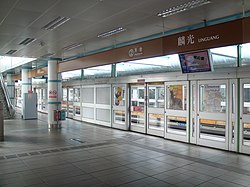Wenshan Line (TRTS)
| Wenshan Line, Taipei Metro | |||
|---|---|---|---|
|
|||

Linguang station, as of 2008.
|
|||
| Overview | |||
| Type | People mover system | ||
| System | Taipei Metro | ||
| Status | Operational | ||
| Locale | Taipei, Taiwan | ||
| Termini |
Zhongshan Junior High School Taipei Zoo |
||
| Stations | 12 | ||
| Daily ridership | 91,400 (December 2008) | ||
| Operation | |||
| Opened | March 28, 1996 | ||
| Owner | DORTS | ||
| Operator(s) | Taipei Rapid Transit Corporation | ||
| Rolling stock | VAL 256, Bombardier Innovia APM 256 | ||
| Technical | |||
| Line length | 10.9 km (6.8 mi) | ||
| Track gauge | Rubber-tired, 1,435 mm (4 ft 8 1⁄2 in) | ||
| Electrification | 1500V Third-rail DC | ||
|
|||
| Wenshan Line, Taipei Metro | |||||||||||||||
| Traditional Chinese | 文山線 | ||||||||||||||
|---|---|---|---|---|---|---|---|---|---|---|---|---|---|---|---|
| Simplified Chinese | 文山线 | ||||||||||||||
|
|||||||||||||||
| Transcriptions | |
|---|---|
| Standard Mandarin | |
| Hanyu Pinyin | Wénshān Xiàn |
| Wade–Giles | Wen2-shan1- Hsien4 |
| Tongyong Pinyin | Wúnshan-Siàn |
| Southern Min | |
| Hokkien POJ | Bûn-soaⁿ Sòaⁿ |
The Taipei Metro Wenshan Line (previously known as the Muzha Line before October 8, 2009) is an elevated, medium-capacity line in Taipei, Taiwan. It was the first line on the Taipei Metro, consisting of 12 stations over 10.9 km. Opened on March 28, 1996, after construction delays compounded with legal tussles, the fully elevated people mover system is driverless and fully automated. A full-length journey on the line takes 22 minutes, and it is labelled as part of the Brown Line on the Taipei Metro. Currently, services are operated using 4-car Bombardier Innovia APM 256 rolling stock as well as the retrofitted VAL 256 trains and directly connect to the Neihu Line.
Construction of the Wenshan Line began in December 1988 at a cost of NT$42.6 billion. It was plagued by controversy, cost overruns and technical problems from its development up to a few years after its opening. Originally slated to commence passenger service in December 1991, its revenue operation was repeatedly delayed up to 28 March 1996 owing to numerous accidents. Public confidence was shakened as incidents of lightning strikes, computer failures, two instances of rolling stock derailment and catching fire each were reported during the testing phase. In 1999, cracks were found on the elevated pillars forcing the line to shut down temporarily.
One of the largest suppliers for the system, Matra, which supplied the VAL 256 rolling stock and electrical systems for the line sued the Department of Rapid Transit Systems of the Taipei City Government for costs overruns claiming to have resulted from the latter failing to provide the necessary infrastructure to build the line. Subsequently, the company pulled out of the operation of the line in 1994.Chen Shui Bian, then Mayor of Taipei declared that progress and operation of the line would continue despite the walkout in the now-popular catchphrase "馬特拉不拉,我們自己拉" (lit: If Matra doesn't pull, we'd pull it ourselves). After a 12-year-long legal tussle, in 2005, Matra was awarded NT$1.6 billion (approx. US$50 million) in damages by the Supreme Court of the Republic of China.
...
Wikipedia
